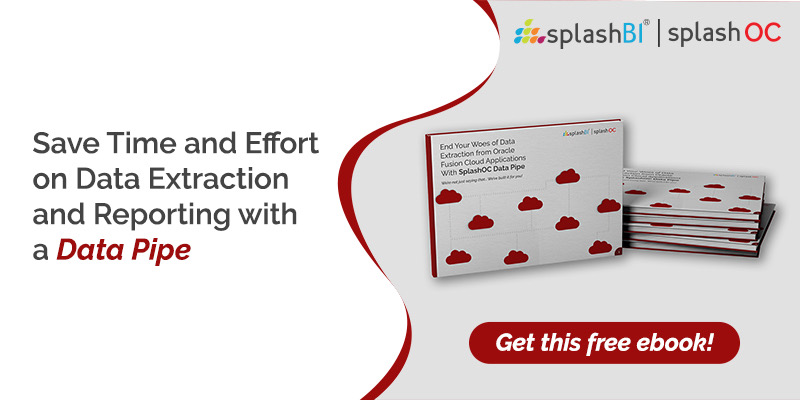The modern-day enterprise deals with enormous volumes of data every day. However, data collected through now-omnipresent technologies such as IoT, BI tools, and cloud/SaaS environments are generally scattered in disparate silos.
Making sense of the isolated data for in-depth analysis and reporting becomes a hassle, beating the very purpose of data generation and collection. In addition, businesses are investing significantly in SaaS tools and cloud migration initiatives to transform the scattered data into actionable insights. By adopting these state-of-the-art tools, companies look to democratize the data streams and facilitate insight-led decision-making for every business user irrespective of their IT or data engineering and manipulation skills.
But there’s a catch!
Data formats are heterogeneous in nature, spread across on-premise, hybrid and cloud environments. This makes data extraction a tedious process. For instance, many SaaS-based applications restrict access to their underlying databases, demanding extensive coding and data engineering skills for the most straightforward analytics and reporting needs. As a result, critical data often remains unused due to the lack of a centralized view of all existing data sets.
Common challenges with reporting in the modern enterprise
Companies invest in tools and technologies to democratize enterprise data. After all, making data-driven decisions is the holy grail for business growth. However, most companies struggle to make the most of the data from SaaS and cloud-native ERP systems. Manual data extraction and manipulation are cumbersome and end up consuming a large chunk of human resource costs.
Some of the most pressing challenges with enterprise reporting include:
1. Restricted database access-
A business user generally has to go through the bureaucratic process of access requests and coding for minor reporting needs. As a result, they lose valuable time and cannot perform quick reporting for decision-making at scale. Most SaaS-based applications restrict access to their underlying databases. This can be a tricky spot for enterprises as they would require critical data access at various touchpoints in their operational and decision-making processes.
2. Data is siloed across heterogeneous environments-
Enterprises have a diverse mix of SaaS and on-premise tools to address the needs of different business functions. This causes data silos and restricts holistic cross-application reporting. The back-and-forth flow of data becomes a complex and tedious process. Copy-pasting data for reporting purposes takes up significant time, hampering productivity. As the volume of information increases over time, operating in this manual mode is neither feasible nor efficient.
3. The human resource cost of data manipulation-
The extensive time required for CSV and Excel-based data manipulation restricts the scale of reporting. Creating quick reports for instant data-driven decision-making becomes a challenge. Manipulating data from file-based Excel or CSV formats requires extensive time, and it becomes even more complex as data volume increases. Moreover, hiring and retaining the right data talent is also cumbersome. As a result, this approach is neither scalable nor sustainable, especially for large enterprises that deal with large volumes of datasets daily.
4. The dynamic nature of incremental data-
It is an uphill task to keep up with the incremental SaaS data. Moreover, incorporating incremental data to produce accurate reports for decision-making can be taxing. Seamless data integration for enterprise reporting demands an extensive understanding of IT, data engineering and cloud infrastructure. Business users end up being dependent on IT teams and their expertise to turn their data sets into an asset to accelerate business growth. On the other hand, when they ignore incremental data because of the severe dependencies on other teams, their reporting is neither accurate nor holistic.
These challenges make enterprise reporting far from holistic and often time-consuming, discouraging business users from actually leveraging data in their everyday use cases. Large enterprises that deal with a massive pool of data every day cannot afford to operate in manual copy-paste models or not take their breadth and depth of data into account for decision-making. Investing critical human resources in manual and cumbersome tasks impacts organizational productivity and individual efficiency.
Data pipeline to the rescue
Turning a vast pool of data collected from disparate sources into actionable insights is not scalable if you do it manually. The data sources are many, from data lakes, public documents, SaaS applications, cloud warehouses, and more. Moreover, this data across different formats prevents enterprises from turning every dataset into a competitive advantage. As they say, data is the new oil, but what good is it if it can’t be extracted for the very reasons enterprises invest in data infrastructures?
This is where data pipeline enters the picture.
A data pipeline is a series of automated actions that collects data from disparate sources and moves it to the chosen destination for storage or analysis. That data is ingested either through batch processing (data is collected periodically) or stream processing (data is extracted and manipulated for company use). Finally, the siloed data sets are moved to one centralized platform, where they are converted into a usable format for quick and holistic reporting across the enterprise. Data pipelines replicate the SaaS production environment for effective data manipulation, thus ensuring that your SaaS performance is never impacted due to reporting/manipulation on the production environment.
How does a data pipeline solve your reporting challenges?
Data pipelines are robust and scalable in nature. With them, you can integrate all relevant business data into a single repository in a usable, homogenous format. A data pipeline saves valuable company time by automating the data extraction process and ensuring that the data is in a usable format for reporting, insights and decision-making. With data pipelines, enterprises can leave the extraction process to an automated tool and focus on leveraging these data sets as assets for business growth.
Let us take a look at how data pipelines solve reporting challenges:
1. Deliver quick data extraction at scale
Data pipeline’s no code feature eliminates business users’ dependency on IT and data engineering teams for every data extraction request. In addition, importing the data is now hassle-free as robust data pipelines eliminate manual cleaning of data with a seamless, easy-to-use user interface.
2. Streamline data into a homogeneous format
Data pipeline tools such as those built into SplashBI for Oracle Fusion Cloud deliver crucial data into a usable, homogeneous format for quick and scalable manipulation, gleaning insights and reporting. In addition, the tedious process of optimizing data from various sources is automated, and users can perform data manipulation effortlessly without much prior experience.
3. Connect seamlessly with analytics tools for reporting
A robust data pipeline enables users to connect with analytics tools for timely, up-to-date reporting. In addition, users can make quick data-driven business decisions on the go by seamlessly connecting with third-party analytics tools in a replicated environment. This further encourages holistic, fast and easy reporting for data-backed business decisions.
4. Extract incremental data with scheduling capabilities
Data pipelines warrant the scheduling of incremental data downloads on auto-pilot mode so that your reporting is always holistic and backed by updated and accurate data sets. Now users can access up-to-date data at the frequency that their specific workstream demands. The icing is that different business users can schedule their data extractions, and only the incremental data gets downloaded.
Data Pipeline: Driving your Business Forward with Intelligent Decision-making
Data pipelines empower business users to deliver holistic reports and make insight-led decisions that are good for the business. We have designed the SplashBI for Oracle Fusion Cloud Data Pipeline to address the exact challenges that our customers face with their reporting tools and processes.
SplashBI for Oracle Fusion Cloud Data Pipeline replicates supported SaaS applications’ data to your target database. So, whether you need a data pipeline for reporting & analytics or integrating with third-party apps for holistic decision-making, the SplashBI for Oracle Fusion Cloud Data Pipeline simplifies access to your data.
Our customers highlight that SplashBI for Oracle Fusion Cloud data pipeline’s seamless data flow, combined with SplashBI’s ad-hoc reporting platform, make a perfect solution for business users with varying degrees of IT and data engineering skills. Their favourite feature is how SplashBI Data Pipeline converges diverse data sets for informed decision-making.
Now, leverage the full potential of your data infrastructure by diverting analytics and reporting workload from SaaS production environments and building consolidated cross-application reporting capabilities for your business users.
To read more on Data pipeline and how you can address all the challenges of your data extraction from Oracle Fusion Cloud applications, download our latest eBook.









